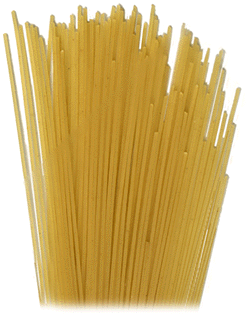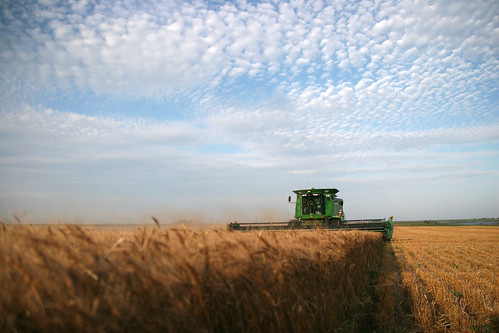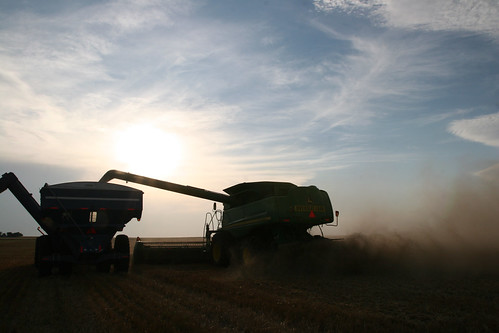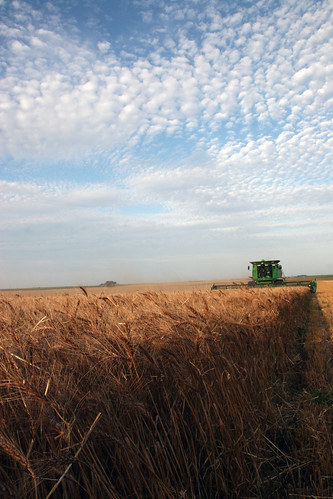Natural yeast breads at Borough Market, London (photo by Teri Carns, 11/24/2011)
People love their natural yeast starters for baking bread. They name them, and narrate their histories in as much detail as their own family trees. They praise the rough crumb of the bread, the browned crust, and the sweet tang and bite of flavor made with their special starter. These mixes of flour, water, and the yeasts and bacteria that grow in them exemplify “terroir,” the French word for all of the qualities of a place embodied in the taste and character of a food or drink. And that helps to explain why they are so cherished. They are living things that embody the qualities of the places in which they grow, and they impart that uniqueness to the breads made with them. But predictable as they might seem, like all families the yeasts and their bacteria have a streak of wildness in them. You can’t predict what nuances of flavors they might come up with and that wildness delights the tongue as well as the soul.
Natural yeast starters are among the most ancient of continually cultivated crops, or if you prefer, livestock, on earth. They combine both yeasts, cousins to mushrooms and the smallest of the fungi, and bacteria, which are more animal than plant. The yeasts that are best-known for both beer and bread are the Saccharomyces cerevisiae, which means sugar (saccharo-) fungus (myces); Cerevisiae comes from Latin and means “of beer.” Hundreds of variants of the S. Cerevisiae cling to plants and float in the air everywhere, the variety depending on the food available for them in the area. Two other yeasts often found in natural starters are Candida milleri or Saccharomyces exiguus.
The Lactobacilli in natural yeast starters are a much more varied group and there are several of them in any given starter. The combinations of Lactobacilli in any given starter depend just as much on the area in which they live as do the yeast combinations. One of the rock stars of the bread world is Lactobacillus sanfranciscensis, the lead creature in the group of Lactobacilli responsible for the unique tang of San Francisco sourdough.
A recent commentary on mushrooms -- the yeasts' cousins, wildness, and terroir described the thinking of well-known forager, Hank Shaw (blog, Hunter Angler Gardener Cook) Beth Pilar quoted Mr. Shaw, “'a wild thing living by its own wits not controlled by land or man" will produce something incomparable to what is grown for predictability and consistency.” Although the yeasts and bacilli can be tamed and sold commercially, if they can thrive in the more natural environment of a starter rather than coming from a carefully controlled factory they will yield more complex and rewarding tastes.
Terroir, the taste of home
Natural yeast starters take advantage of the local water, wheat, yeast and bacteria to express terroir. It is defined as the “‘sense of place,’ . . . embodied in certain characteristic qualities, the sum of the effects that the local environment has had on the production of the product,” is perfectly represented by San Francisco’s sourdough. Its particular taste depends on letting both a bacillus and a yeast that prefer the Bay Area’s environment grow together for under specific circumstances. Taken to another location, the original San Francisco sourdough inevitably begins to lose its former taste and take on the qualities of its new home and the wheat and water that nourish it.
Chefs who are considered the world’s finest rely on breads made with local yeast and wheat. An example is Magnus Nilsson, of Faviken, Sweden, who in a meal that also features caviar in dried ducks’ blood cups and hand-cured hams, brings out the most classic of sourdough breads. “‘Do you see that trough?’ he [Nilsson] asks, pointing to a worn wooden vessel leaning against the wall. ‘That was what my grandmother made bread in. And it’s what we made this bread in as well.’ The wood is so impregnated with yeast that Nilsson no longer adds it to the recipe. In other words, he is not just using his grandmother’s bowl—he is using her yeast as well” [Robb Report, October 2011].
Another commentator who dined at Faviken noted: “This was the same tray that once belonged to Magnus Nilsson’s grandmother and her grandmother before her; it still harbours traces of the same sourdough culture she used . . . now over two hundred years old. The family connection does not end there: with this ancestral starter, flour from Järna near Stockholm and from an island in lake Storsjön processed together at a mill in Östersund, he uses his wife’s recipe to bake a pain au levain loaf that possessed a thin yet crunchy crust and dense, dark yet moist and fluffy crumb.”
Bread and beer, the ancient gifts
Who first figured out that fermentation was such a good thing? The Egyptians usually get the credit for discovering that water and grains left to themselves for a few days begin to bubble and brew, creating both raised bread and beer. But some authorities (Maguelonne Toussaint-Samat, History of Food) say that the Babylonians led the way. “Babylonian beer was cloudy; indeed, the brewers of the time liked to thicken it with flour and let the mixture stand before fermenting it a second time, thus producing something which could be described as edible beer or alternatively drinkable bread. It might sometimes be cooked, and produced a raised cake or loaf.” The author says that the Egyptians took the Babylonian discoveries and became famous, exporting beer to the Athenians; the Greeks took the beer on to Gaul and Spain, and from there it quickly spread to the rest of Europe.
The History of Food suggests near the end of the Middle Ages someone rediscovered the use of beer yeast to raise the bread. Marie Medici “liked it so much that it was called Pain a la Reine, after her.” Until the 19th century, a starter was the only method of making yeast breads. In the late 1700s and early 1800s, the Germans and Dutch began to develop cultures of yeast to sell for bread baking. Breeding strains of the standard bread yeast, Saccharomyces cerevisiae, to be consistent in flavor and easy to use and store meant that breads gradually lost their local uniqueness and became sweeter in taste. This was a good thing because if a starter went bad, it didn’t take a week to get another one going. It was easier to make a variety of breads, both at home and commercially, and to be sure that they would all have the same qualities.
Leeuwenhoek in Holland discovered the wild little creatures that made bread rise in his homemade microscopes in 1680, but it was Louis Pasteur in the mid-1800s who demonstrated their role in fermentation. Others refined the discoveries, and found that while yeast produced the carbon dioxide that stretched the gluten in wheat flour, and made the bread rise, it was a bacterium or several that gave sourdough bread many of its distinctive flavors.
Grow your own
Aficionados of natural yeast starters, passionate about their methods and discoveries, have shared a wealth of knowledge and technique through books and the Internet. A pathologist, Dr. Ed Wood, who took a fancy to sourdough set out to replicate the breads baked in conical ovens found in Egyptian tombs. He hypothesized that although the original yeasts and bacteria were not available, their direct descendants would still be floating around. And although no recipes were available, by experimentation he thought that he could recreate a dough and cooking techniques that would produce breads that the Pharaohs would recognize.
Dr. Wood found local wheat and had it ground using techniques that were depicted in paintings and sculptures from four thousand years ago, blended it with Cairo water, and let it sit out on the balcony of his hotel at night to gather yeasts and bacteria. After a week of cultivating the starter, he experimented with mixing doughs and baking them in the clay ovens. Pleased with the results, he has written two books on the topic, World Sourdoughs from Antiquity, and Classic Sourdoughs.
Dr. Wood’s techniques are similar to those used by many other authorities on natural starters, but of course, each expert vigorously defends his or her way as the right way. Most agree on a few basic steps, but debate many of the points about when to feed the starter, what to feed it, how warm to keep it, and more. The food chain in a natural starter begins with the food: wheat flour and water, mixed and left sitting in a bowl in a comfortably cool place (65 degrees is recommended, to give time for the richest tastes). The life in the starter, the yeasts and bacteria come from both the flour itself which is alive with microorganisms, including yeast and bacteria, and from those that are always floating through the air. Some land on the damp surface, and settle in along with those that rode in on the wheat. The yeasts eat the starches and sugars in the wheat, giving off alcohol and carbon dioxide. The Lactobacillus bacteria also eat the starches and sugars, but at a slower pace. They thrive in the acidic environment created by the yeasts, and add nuances to the tastes in the starter. A starter has to be given food (flour) and drink (water), or hibernated in a refrigerator or freezer because the yeasts and bacteria are living creatures using up the available nourishment. One blogger, Wardeh Harmon on passionatehomemaking.com offers an explanation:
"Regular flour feedings keep the organisms fed and in balance. But missing a feeding gives the bacteria a leg up. You see, the yeasts run out of food when the simple sugars in flour are all consumed, and they start dying off. But the bacteria still have food to eat. They eat the expired yeasts, along with the yeasts’ wastes, and continue to produce lactic acid, the main sour flavor. And so the starter gets more sour."
Start with wheat and water that are as close to home as possible. The wheat is more of a challenge, because it’s mostly grown in temperate climates that aren’t at extremes of heat or cold. It should be noted here that people make yeast ferments for starters from almost anything – rice, dandelions, any plant substance can be fermented, and will supply a yeast culture that will raise gluten-containing flours into breads. But this description focuses on wheat, so choose a wheat that was grown as near to your area as possible. Water can almost always be local, although it can be left to sit out to dissipate chlorine, or filtered or boiled to purify it.
Samuel Fromartz, writing about Tartine Bread, one of the most noteworthy new books on natural breads says:
"[Chad] Robertson's [author of Tartine Bread] main departure from standard practice comes with his natural leaven (I'm loathe to use the word sourdough, which is a misnomer, since this leaven is anything but sour). Unlike most leavens made with white flour, he uses 50% white and 50% whole wheat flour. Normally, that would lead to an explosion of activity, since the minerals and bran in whole wheat flour make for a very active starter that can be difficult to master.
But he tackles this problem by doing two things: first mixing a large amount of leaven - 400 grams total, or 2-3 cups - with just a tiny tablespoon of starter. Then he ferments it at a rather cool temperature to reduce its activity. The result is a mildly flavored leaven which when added to the dough inoculates the mix with copious amounts of yeast but has very mild acidic notes. Shining though is the sweetness of the wheat, which is probably why San Franciscans line up to get their hands on this bread. Plus the loaves just look gorgeous, judging from the pictures in the book by Eric Wolfinger."
Making a starter from scratch takes several days of feeding the yeasts and bacteria new flour and water daily (or oftener) to eat so that they can continue to grow and develop more complex flavors in the dough. But once the starter has matured, it can hibernate in the refrigerator for months at a time, getting warmed up and fed once a week, and then going back to its chilly den to rest. Feeding the yeasts new flour oftener, or adding sugars to the dough, makes a sweeter taste; letting the bacteria have more play gives more sourness. Peter Reinhart, in Crust and Crumb, describes this process in great detail, observing that creating a starter like this is “essential for attaining world-class results in many breads.”
Natural yeast breads at Borough Market, London, (Photo by Teri Carns, 11/24/2011)
More detailed instructions are beyond the scope of this article. Two very different approaches are favored by Peter Reinhart and Chad Robertson. Peter Reinhart’s technique is described in his books; go to http://www.breadtopia.com/make-your-own-sourdough-starter/ for an Internet source for an adaptation. Here is a recipe for making Chad Robertson’s starter and a loaf of Tartine Bread. There are dozens more subtleties described in the care and feeding of natural starters by different writers, so choose one that works reliably for you, and enjoy experimenting. The cook is also an essential part of the terroir of the starter.




